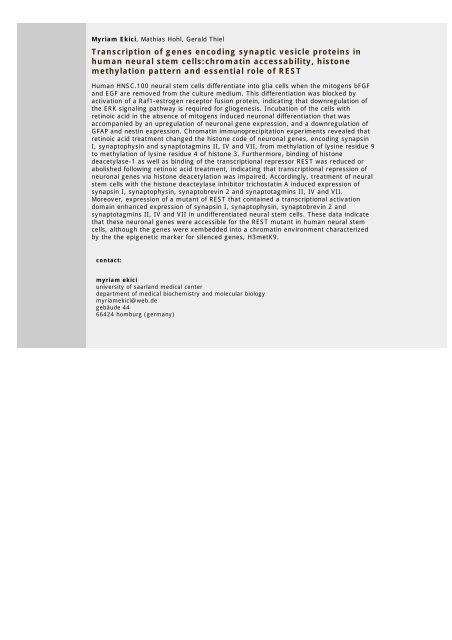Abstracts (poster) - Wissenschaft Online
Abstracts (poster) - Wissenschaft Online
Abstracts (poster) - Wissenschaft Online
Create successful ePaper yourself
Turn your PDF publications into a flip-book with our unique Google optimized e-Paper software.
Myriam Ekici, Mathias Hohl, Gerald Thiel<br />
Transcription of genes encoding synaptic vesicle proteins in<br />
human neural stem cells:chromatin accessability, histone<br />
methylation pattern and essential role of REST<br />
Human HNSC.100 neural stem cells differentiate into glia cells when the mitogens bFGF<br />
and EGF are removed from the culture medium. This differentiation was blocked by<br />
activation of a Raf1-estrogen receptor fusion protein, indicating that downregulation of<br />
the ERK signaling pathway is required for gliogenesis. Incubation of the cells with<br />
retinoic acid in the absence of mitogens induced neuronal differentiation that was<br />
accompanied by an upregulation of neuronal gene expression, and a downregulation of<br />
GFAP and nestin expression. Chromatin immunoprecipitation experiments revealed that<br />
retinoic acid treatment changed the histone code of neuronal genes, encoding synapsin<br />
I, synaptophysin and synaptotagmins II, IV and VII, from methylation of lysine residue 9<br />
to methylation of lysine residue 4 of histone 3. Furthermore, binding of histone<br />
deacetylase-1 as well as binding of the transcriptional repressor REST was reduced or<br />
abolished following retinoic acid treatment, indicating that transcriptional repression of<br />
neuronal genes via histone deacetylation was impaired. Accordingly, treatment of neural<br />
stem cells with the histone deacteylase inhibitor trichostatin A induced expression of<br />
synapsin I, synaptophysin, synaptobrevin 2 and synaptotagmins II, IV and VII.<br />
Moreover, expression of a mutant of REST that contained a transcriptional activation<br />
domain enhanced expression of synapsin I, synaptophysin, synaptobrevin 2 and<br />
synaptotagmins II, IV and VII in undifferentiated neural stem cells. These data indicate<br />
that these neuronal genes were accessible for the REST mutant in human neural stem<br />
cells, although the genes were xembedded into a chromatin environment characterized<br />
by the the epigenetic marker for silenced genes, H3metK9.<br />
contact:<br />
myriam ekici<br />
university of saarland medical center<br />
department of medical biochemistry and molecular biology<br />
myriamekici@web.de<br />
gebäude 44<br />
66424 homburg (germany)

















